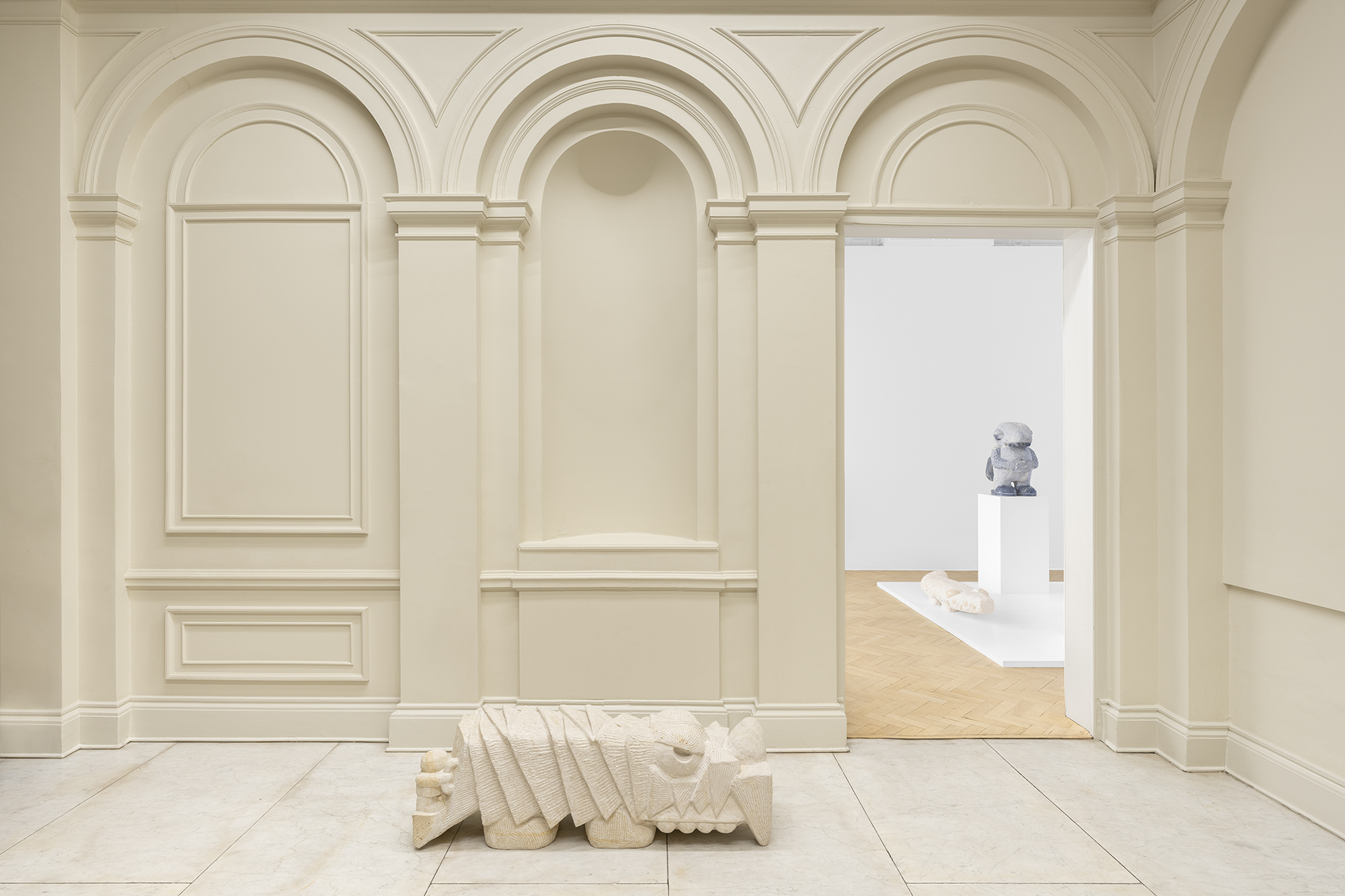
About
Welcome to Stefan Rinck's Four Seasons Of My Soul, a therapeutic chamber piece, a motel of emotional states inhabited by eerily endearing owls, gently diabolical figures such as Almohad Owl, Charcot, and Tourettinger, alongside other grotesque, amused beings like Pink Pythagoras and Monitored Snail.
The exhibition opens with the Cabinet of Colors, where the focus is on the connection between colors and emotions—each as diverse as the objects in a cabinet of curiosities. With works like Alienation in green quartzite, Mammoth Pompadour in pink marble, or the ferryman Charon in red marble, Rinck combines humorous, almost grotesque elements with reflections on cultural archetypes and myths. Blue Chip, meanwhile, seems to reference the language of the art market while simultaneously invoking the color-therapeutic idea that blue conveys calm and stability.
The Schlemmer Suite is dedicated to the world of the Bauhaus. Sculptures like Shapehead, Cube Head, Utopia, Abstractionist, or Duc de Bonbon appear as boundary-crossers between eras and styles—part Rococo, part Bauhaus. They embody the desire for clarity, yet they also embrace the shadows of modernity. In works like Homo Belgicus, carrying a sack of Belgian francs, Rinck’s ironic detachment shines through, reflecting not only art history but also societal conditions. While the forms align with abstract ideals, the titles recall a world where aesthetics and capital, utopia and pragmatism, intertwine seamlessly.
The exhibition continues with The Hospital, where visitors are metaphorically admitted as patients. The hospital represents a place of healing but also of diagnosis and examination. The sculpture’s titles allude to historical and literary figures: Charcot, Cesare, or Antisaccard. Jean-Martin Charcot, founder of modern neurology, represents scientific occupation with mental disorders and hysteria. Rinck’s Charcot leads us to the origins of psychoanalysis and the room transforms into a space where the boundaries between body and mind are questioned. Cesare refers to the somnambulist from The Cabinet of Dr. Caligari—a figure both victim and instrument, trapped between wakefulness and dream. Rinck picks up on this ambiguity, turning The Hospital into a stage where unconscious drives and dark desires come to light.
Antisaccard, on the other hand, refers to Eugène Rougon, known as Saccard, the protagonist of Émile Zola’s novel Money (1891). Saccard is a flamboyant figure of French financial capitalism—a ruthless speculator driven by greed and ambition. He embodies the moral fragility and corruption of the capitalist system, yet also its indomitable, almost mythical energy. Rinck’s Antisaccard defiantly clutches a sack marked with a dollar sign, his expression skeptical to angry—a commentary not limited to capitalism critique but also reflecting contemporary social or political conflicts.
Stefan Rinck’s sculptures are characterized by a range of classical stonemasonry techniques and a variety of stone types. Whether in sandstone or marble, each material is thoughtfully chosen to emphasize the character of the figures depicted. This process reflects the idea that healing often involves a conscious engagement with the various layers and facets of one’s own personality. The rough, archaic-looking treatment of the sculptures evokes the raw, unspoken emotions that emerge during psychological work. At the same time, the fine details recall the sensitive, often hidden aspects of the self.
Finally, we arrive at the fourth and final room, the Owl Chamber, which serves as a gateway to an introspective journey. Here, titles such as Owl of Metzengerstein or Owl of Berlifitzingen—suggest connections to Edgar Allan Poe’s tales, whose literary worlds frequently navigate the thin line between life and death, reality and nightmare. Rinck’s owls embody this twilight spirit. However, they are not merely reflections of Poe’s melancholy; they also evoke other cultural connotations. The phrase carrying owls to Athens is poetically subverted: in Rinck's interpretation, the owl is not a redundant symbol, but a necessary, recurring, even existential vehicle—transporting the soul and serving as a companion on the journey from this world to the next. These echoes of the owl’s mythological role as a psychopomp—a guide for souls—imbue the Owl Chamber with an almost ritualistic dimension.
The sculptural depictions also recall the figure of the owl-human—a hybrid being, part bird, part human. While the lark-human in mythology is often associated with alertness, adaptability, and the earthly cycle, the owl-human represents the hidden, nocturnal, and liminal space between life and death.
Annekathrin Kohout
















